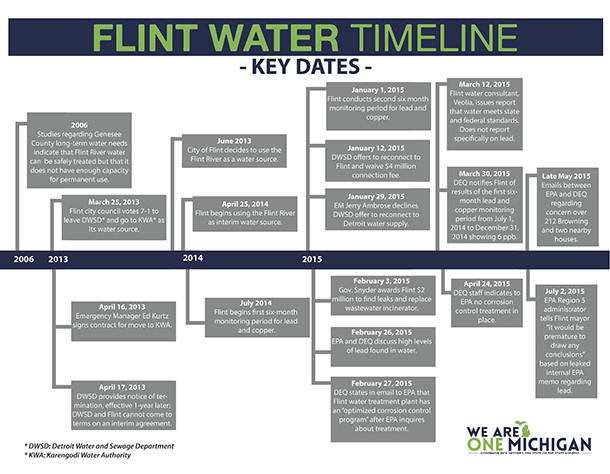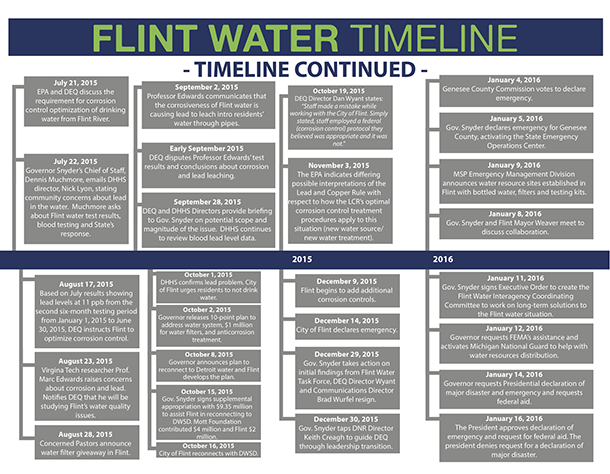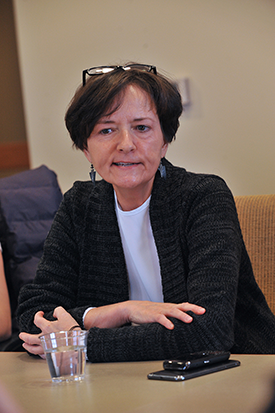Flint's Drinking Water Disaster
Air Date: Week of January 22, 2016

Protesters in Ann Arbor, Michigan called for the arrest of Governor Rick Snyder on Jan. 18th, 2016. (Photo: courtesy of Dennis Sparks)
The powerful neurotoxin lead began leaching into the municipal water supply of Flint Michigan in April of 2014 when the city switched its water source and failed to add anti-corrosion agents. Virginia Tech water treatment and corrosion expert Marc Edwards tells host Steve Curwood about a string of mistakes and lies on the part of officials that led to the disaster that especially endangers child health.
Transcript
CURWOOD: From the Jennifer and Ted Stanley studios at University of Massachusetts Boston and PRI, this is Living on Earth. I’m Steve Curwood. The drinking water disaster in Flint, Michigan began shortly after a change in its source as part of a cost-cutting measure in June 2014. Residents complained that their tap water suddenly smelled and looked bad, but local officials insisted it was safe. Still, LeeAnne Walters, a mother of four, wasn’t convinced, and she started to investigate further. She told Jack Olmstead of GMO Free Radio why she was so worried.
WALTERS: My child with a compromised immune system quit growing. We all developed rashes, we were losing our hair, and we knew something was wrong and kept getting told nothing was wrong. And by talking with other families, we figured out this was going on not just in my home and not just in the homes that had brown water, but all throughout the city and nobody was listening to us.
CURWOOD: LeeAnne Walters' investigations eventually led her to one of the foremost experts on the problem of lead in water, Marc Edwards, a civil and environmental engineer professor at Virginia Tech. He spoke with Living on Earth in 2009, when lead from aging pipes in Washington, DC, was also leaching into drinking water. Professor Edwards was called in to analyze Flint’s water and he’s on the line now from Virginia Tech. Welcome back.
EDWARDS: Thank you for having me.

Michigan Governor Rick Snyder’s office released this Flint Water timeline to address questions on who knew what and when. According to the FlintWaterStudy, this timeline is missing some information, but overall is reasonably accurate. (Photo: Office of Michigan Governor Rick Snyder)
CURWOOD: So briefly what has happened in Flint with its water supply?
EDWARDS: What's happened is an entirely preventable man-made disaster that started out by not following federal law that requires addition of a corrosion control chemical to the water supply to protect the iron and lead pipes from corrosion. And this occurred during a switch from Detroit water that the city been using for a period of decades to Flint River water which runs through the town - it's a little bit of a saltier water source, a little more corrosive - and once that water was put into the system, a perfect storm of corrosion was unleashed. Red water, iron rust falling off of pipes was coming out of people’s taps at very very high levels. Lead was leaching into the water supply from the earliest days and pipes were breaking literally in the streets due to the high corrosion.
CURWOOD: Now, there's no way as a consumer to know that there is lead in your water. You might notice all that iron but you wouldn't be able to notice the lead, right?
EDWARDS: Well, unfortunately, there is a way, and it's the hard way. A mother found out her child was lead poisoned in Flint and figured out that not only was her water lead high, but that the state claims in writing to the EPA that they had been doing corrosion control was a lie. So you can't see lead, you can't taste it, but a mother could see that her child was not developing normally because she had twins and one of them was lagging, and she figured it out all on her own.

Timeline, continued. (Photo: Office of Michigan Governor Rick Snyder)
CURWOOD: How high where the lead levels in the drinking water there in Flint? How's that compare to what's legal?
EDWARDS: When we got involved with this hero Mom as I'll call her, LeeAnne Walters, we helped her sample her water supply and it was the worst lead in water I have seen in 25 years in this field.
CURWOOD: What were the numbers?
EDWARDS: The World Health Organization recommends that the most you ever drink in water is 10 parts per billion, and the water coming out of her tap was 13,500 parts per billion. This is more than 1,300 times higher than recommended levels, two times hazardous waste levels and that's not even the worst of it. She flushed her pipe for 20 minutes trying to clean it out and even after 20 minutes it was in the thousands of parts per billion.
CURWOOD: Mark, remind us of the health effects of lead, particularly in unborn and young children.
EDWARDS: Lead is the best-known neurotoxin. It adversely affects every system in human body. And for that reason, we pay people and pay them well to protect us from this hazard so that something like Flint would never happen, and unfortunately they failed miserably at doing their job.
CURWOOD: So this is a function of not putting this additive into the water that would keep this leaching out of the lead. What exactly was the reasoning of the city, of the government, to take this step? Why not add this?
EDWARDS: I think probably it started out innocently enough. I think they forgot to follow the law, but months and months into this...I mean, realize this is played out over about a 20 month time period, there was warning sign after warning sign that there were serious problems. Residents were getting red colored water coming out of their taps. They literally could not drink this water even though they were paying the highest water rates in the nation. General Motors, which has a plant in Flint, noticed that the water was eating up their car parts and had to stop buying Flint water and switch to a different water source, and the state was claiming all that time that there was nothing wrong at all. And even when they started detecting high lead in the water and they should've known better, rather than admit that they were breaking the law which not only they knew but the EPA regional office knew well since April of 2015, they didn't tell anybody. And so these outside people were figuring out these problems, while the very agencies that we paid to protect us from lead in water were lying to each other in writing. They were telling the public that the water was completely safe. If anyone said anything to the contrary, as we did when we started working with the residents, we were attacked. In fact, had outside people not gotten involved and exposed this, Flint kids would be drinking that water to this day.
MLive Video from Michigan media collaboration
CURWOOD: I understand there was a person that worked at the U.S. Environmental Protection Agency, the EPA, who had spoken out saying the water was unsafe. What happened to that person?
EDWARDS: Well, his name is Miguel del Toro, and he reached out to LeeAnne Walters and was the first one to really work with her and figure out that something was amiss in Flint. And he wrote a report that was very damning. It noted that Flint was not following federal corrosion control laws, that one child had already been poisoned and that the entire city was in imminent peril, and he leaked that to the press, and instead of taking it seriously, the Michigan State Department of Environmental Quality and even worse his boss, a political appointee, buried this memo, told him he could not talk to anyone about the Flint situation and actually went on a campaign to discredit him. What's happened here is a complete failure of our government. In this case, the EPA could've and should've been the heroes. Their employee did this amazing thing to protect the population, even put his job on the line to do so, and his boss snatched defeat from the jaws of victory, and covered this up and sat silently by for about eight, nine months while the city was just on the verge of civil unrest.

Michigan Governor Rick Snyder released nearly 300 pages of emails on Jan. 20th in connection with the crisis in Flint's contaminated water supply. (Photo: Michigan Municipal League, Flickr CC BY-ND 2.0)
CURWOOD: Marc, I know you've been studying city water supplies for much of your career. I imagine this is the worst case you have encountered.
EDWARDS: Actually it's not the worst case that we’ve seen. The worst case was actually in Washington, DC, from 2001 to 2004, and it was very similar. The agencies paid to protect us from lead in water, the United States Environmental Protection Agency, they were trying to do something good by changing disinfectants in the water supply and this new regulation triggered a massive lead contamination event, the worst in modern US history, and I think that the EPA was not used to being the bad guy, and emails that we uncovered as result of that investigation showed they knew about this contamination event and hid it from the public for three years until the Washington Post uncovered it and Washington DC went crazy. And unfortunately, rather than learning from that tragic event which we now know 10 years later, thousands of children were lead poisoned, there was a higher incidence of miscarriages and fetal death, which is an expected impact of lead in water exposure, and unfortunately the US Centers for Disease Control and EPA colluded to completely cover this problem up. They wrote a report at the height of the media outcry. It said not a single man, woman or child had blood lead elevated over the level of concern and that this was all much ado about nothing. Unfortunately that false statement stood for five years until I wrote a paper in 2009 and there was a congressional hearing that just reamed the CDC for their indefensible scientific reporting. Since that, we have dedicated ourselves to trying to prevent another DC from happening. Unfortunately we were unsuccessful. What you're seeing unfold in Flint is exactly the same thing that we saw before in Washington, DC, and no one was ever held accountable for covering up the problem and no one was held accountable for writing falsifying scientific reports and because no one was held accountable, what these agencies learned is nothing.
CURWOOD: Mark, what do you think it'll cost to clean the situation up?
EDWARDS: We estimate that extra damages done to the system are on the order of about $200 million, and that constitutes the damage to the city-owned pipe system and hasn't yet fully accounted for the damage to their home pipe systems. On top of that you have the human costs, the public health costs of childhood lead poisoning and increased help that these children will need in the years ahead. So the price tag is just astronomical. I mean, this is not only a public health disaster, it's one of the worst fiscal decisions I've ever seen.

Susan Hedman, Administrator for EPA's Region 5 office, has come under scrutiny for the agency's alleged mismanagement of the Flint water crisis and has resigned. (Photo: Gerald R. Ford School of Public Policy, University of Michigan, Flickr CC BY-ND 2.0)
CURWOOD: So there are, what, more than 50,000 public drinking water systems around this country. How many of them have old lead pipes in them that could leach out lead that would be toxic if the wrong quality of water was passed through them?
EDWARDS: That's a very good question and no one has the answer to that. There are estimates that there're as many as 13 million lead pipes that connect homes to water mains across the United States, and while they are concentrated in certain cities and certain time frames when the house was built, no one really knows where these lead pipes are. So this is a major barrier to fixing this problem because over the years we've lost track of where these lead pipes are, and there's a good book written on this that called the decision to put these lead pipes in the ground in the first place one of the greatest environmental catastrophes in US history, and unfortunately we're still dealing with the legacy of that.
CURWOOD: That was Marc Edwards, an environmental engineering professor at Virginia Tech. We contacted the EPA for comment. They admit they failed to act quickly enough but also fault state and local officials. Meanwhile, President Obama has declared a state of emergency and Michigan Governor Rick Snyder has publicly apologized and promised to fix the problem.
Links
About Marc Edwards and the Virginia Tech Research Team
Coverage of Flint lead crisis by date
State of Emergency Declared Over Man-Made Water Disaster in Michigan City
Video: Water Sampling Kits for Lead
The EPA’s Safe Drinking Water Act
The Lead and Copper Rule for drinking water
Living on Earth wants to hear from you!
Living on Earth
62 Calef Highway, Suite 212
Lee, NH 03861
Telephone: 617-287-4121
E-mail: comments@loe.org
Newsletter [Click here]
Donate to Living on Earth!
Living on Earth is an independent media program and relies entirely on contributions from listeners and institutions supporting public service. Please donate now to preserve an independent environmental voice.
NewsletterLiving on Earth offers a weekly delivery of the show's rundown to your mailbox. Sign up for our newsletter today!
 Sailors For The Sea: Be the change you want to sea.
Sailors For The Sea: Be the change you want to sea.
 The Grantham Foundation for the Protection of the Environment: Committed to protecting and improving the health of the global environment.
The Grantham Foundation for the Protection of the Environment: Committed to protecting and improving the health of the global environment.
 Contribute to Living on Earth and receive, as our gift to you, an archival print of one of Mark Seth Lender's extraordinary wildlife photographs. Follow the link to see Mark's current collection of photographs.
Contribute to Living on Earth and receive, as our gift to you, an archival print of one of Mark Seth Lender's extraordinary wildlife photographs. Follow the link to see Mark's current collection of photographs.
 Buy a signed copy of Mark Seth Lender's book Smeagull the Seagull & support Living on Earth
Buy a signed copy of Mark Seth Lender's book Smeagull the Seagull & support Living on Earth

